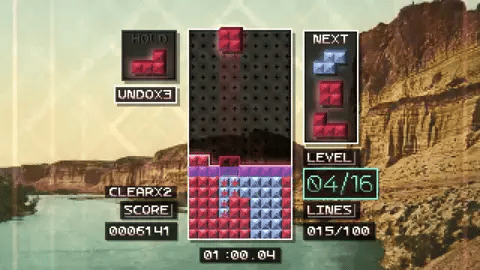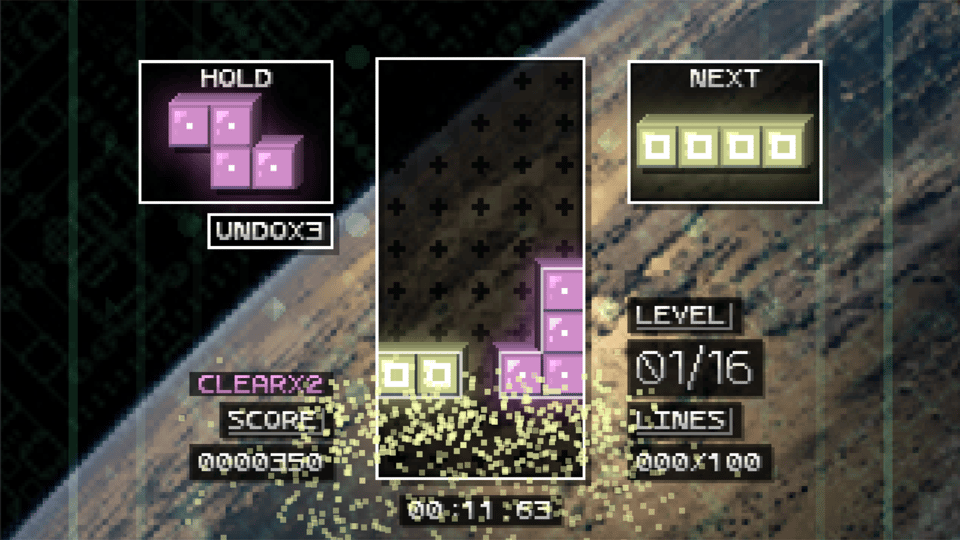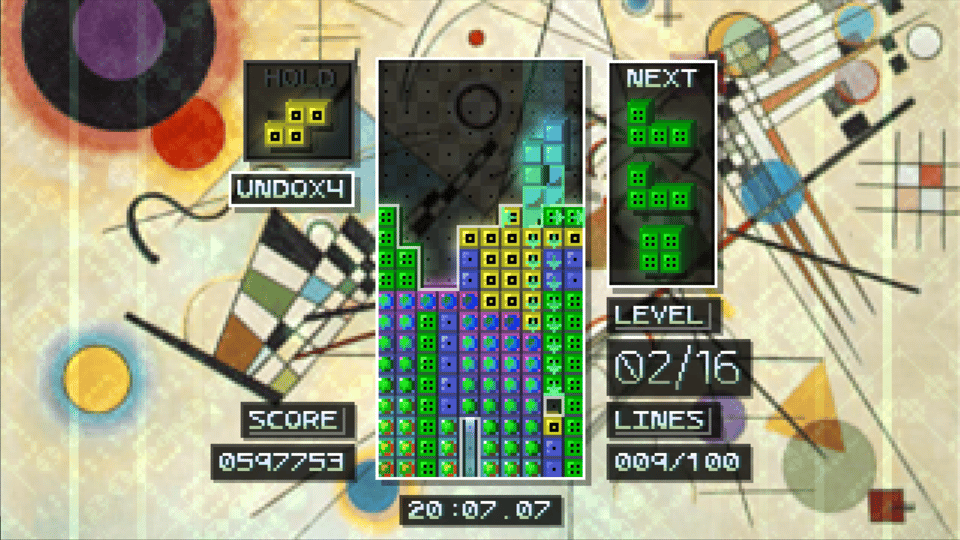Interview With Tetrachroma Creator sparsevector
Recently, I've been enamored with the new falling block puzzle game Tetrachroma, a fiendishly mind-bending fusion of Tetris and Reversi. Questions about its creation started bubbling up in my head while playing, so I reached out to sparsevector, Tetrachroma’s developer for an interview.

Could you introduce yourself and give a little background on your history as a developer?
Hi! My name is Andrew (he/him) but I develop games under the name sparsevector. I'm from a computer science background but was drawn into solo game development because it combines many of my interests and passions. I started working on games in 2012 with a small Oregon Trail parody called Super Amazing Wagon Adventure which ended up succeeding beyond my expectations. After many false starts, I released my second game Tetrachroma this year. Tetrachroma is a block stacking puzzle-action game that mixes tetromino stacking with a color-changing mechanic inspired by Reversi. The game uses the same piece shapes as Tetris, but in order to clear a line the colors have to match, and pieces transform adjacent lines like Reversi.
Your previous game, Super Amazing Wagon Adventure, came out in 2012 with a very positive critical response. I'm all too familiar with burnout, scope creep, and the pressure to always improve upon the last game, and how it can freeze up the creative process. What got you over that hump, and how has the indie landscape changed since the last time you did a commercial release?
Super Amazing Wagon Adventure's surprise success raised my expectations for myself, which in hindsight really did set me back creatively. I had trouble managing the scope of my next few projects and can still struggle with self-confidence related to my work. The indie landscape has also become much, much more competitive since 2012. Back in 2012, the belief was that a great game would naturally find its audience. I think there's still some of that optimism today, but it feels like the quality needed to ensure a game's success has become almost unattainably high.
In 2023, I decided to take a step back and make a small "test game" for the C++ game library I was coding. I felt I was risking another burnout and needed a new approach. I remembered an old idea of combining Reversi with Tetris which I never got around to testing, so I thought I'd try it out. The mechanic ended up having a lot more depth than I expected, and the "test game" turned into Tetrachroma. For me, just finishing and releasing something was a big personal victory, but the project ended up being something much more than that.

Tetris is such a foundational game that I think every game designer has at least pondered their own twist on it. Having tried a lot of them, Tetrachroma's gameplay stood out to me as uniquely gripping. What factor do you think makes for a really interesting falling block puzzle game these days?
I think the most interesting feature of Tetrachroma's gameplay is the way the game forces you to manage color dynamics and structure at the same time. It feels a bit like playing two interwoven games at once. I think there's a lot of similar ideas worth exploring by combining ideas from different games and genres. Working in a well-established genre like falling block puzzle games, it can sometimes feel like everything has been done already, but there’s plenty of unexplored territory.
In your design and prototyping process, what made you realize you were onto something that you wanted to develop into a full release?
I initially had the idea for the game's core mechanic way back in 2019, but it didn't strike me as so important I needed to try it out right away. In fact, I’m not even sure that I wrote it down. Instead, it sat in the back of my head, until I started working on my "test game" in 2023. When I finally tried out the idea, I pretty much instantly fell in love with it. I wasn't sure at first if I wanted to make it into a commercial game, but it felt worth exploring, and the more I explored the more I wanted to play. In a weird way, the entire project feels like it is in service to this one gameplay idea.
I've found that high level players of this genre come with a lot of expectations around things like very specific control settings, piece randomization, and block rotation mechanics. What was your background in working on or playing games like this, and what did you learn and improve upon based on player feedback?
I've been a fan of the genre since childhood, but I still had so much to learn while developing this game. The development of the game became a window for me to explore the history of the genre and the community. I tried to embrace the complexity of the genre with the different modes inspired by different styles of block stacking: an Arcade mode inspired by Tetris: the Grandmaster 2, an Instant mode inspired by modern speed focused fan games, etc. These modes ended up producing a lot of feedback after launch as players wanted new control options for the new modes and expert players found inconsistencies and mistakes in their details. It's been a lot of work, but the game is much better as a result!
A small, somewhat technical example: the game allows you to modify the “hard drop” and “soft drop” settings to emulate a specific mechanic from the Tetris the Grandmaster series called “sonic drop”. The initial release had a subtle difference in how this was implemented which I thought was inconsequential. Unfortunately, this difference turned out to affect a control technique called a “Zangi-move” where you spin the arcade stick in a circle. I’m not an arcade stick player, so I overlooked this, but an expert brought it to my attention. This has been patched!

Tetrachroma has a fascinating difficulty curve due to the way additional colors wind up interacting with each other on the board and fundamentally affect strategy in each phase. While most games in this genre ratchet up difficulty until a big finish, Tetrachroma's final stage in Marathon mode feels like a hard-won victory lap. What was your philosophy in designing this progression?
With the Marathon mode, I knew I wanted to introduce new colors and mechanics over time, and also that starting with one color wouldn't make sense. The game has to start with at least two colors to show the new color mechanics right away. At the same time, I also didn't want to exclude the "one color" gameplay from the game. This led to the idea of stripping out the color-matching gameplay in the final stage for a sort of victory lap finale. One of the things I find most interesting about the game's color-changing mechanics is how changing the number of colors produces a subjectively different gameplay experience. Instead of three colors just feeling like just a more difficult version of two colors, it feels slightly more subtle than that. I like that the Marathon format encourages players to think about how the gameplay changes as a result of the changing number of colors. I also like that the final victory lap feels a bit like a return to the familiar after a long strange journey.
Something I love about Tetrachroma is that my years of ingrained Tetris habits and reflexes absolutely do not serve me in this context. What might result in a neat stack of blocks will turn out to be a disaster for the colors. Can you describe your process of developing gameplay strategies while creating a game with such fresh mechanics? What new strategies have you learned from players after release? Have you got any hot tips on how to become a better Tetrachroma player?
When I first began playing prototypes of Tetrachroma, I was captivated by the mechanics, but it honestly took me about a week of regularly playing before I felt I could competently play the game at all. The current version of the game is much easier to learn thanks to many visual indicators, but still pretty challenging in comparison to the average game in this genre. I mostly learned through playing and experimenting, but I've slowly developed some more deliberate strategies. Unfortunately, I've not had a lot of time to play the game for fun or study expert players' strategies since release, but I'm looking forward to that!
Tetrachroma gameplay tends to ebb and flow with the stack slowly growing over time until there's a lucky piece sequence. A tip I have for new players is don’t be afraid to temporarily "dirty" the structure of your stack in order to secure a big line clear. Although you always have to think about color and structure, which is most important depends on the situation. Generally, structure tends to be more important when the stack is short, and color tends to be more important when the stack is tall.

Tetrachroma's aesthetic is boldly eclectic, especially the soundtrack. How did you go about choosing public domain works for the background images and musical compositions, and what guiding principles did you keep in mind to arrange them into a coherent vibe? What would you call the style of Tetrachroma?
The way I would describe the style of Tetrachroma is "romantic false nostalgia". Something I thought about while making the game is how most Tetris players have a memory of learning the game which borders on remembering a first romantic love. One of the most ambitious goals of this game is to give you the experience of learning Tetris again for the first time. But the game also knows that this is an impossibly ambitious goal. You'll never get to experience that again, just like you can't have another first romantic love. This is where the element of "false" comes in: this isn't Tetris, it's something different, and it’s not how you remember.
To give an example, the backgrounds used in the game's "Standard" mode look like old stock color photos but are actually something called photochrom prints. Photochrom is an archaic technology from the late 1800s and early 1900s where the photographer would take a black and white photo and then later hand paint the negative to create color layers. This allowed publishers to produce cheap color prints for postcards without using expensive color film, but it gives these images a very otherworldly, dreamlike quality where colors are beautiful but not at all accurate. I love it!
Similarly, with the music I use romantic and modern era classical music as a starting point, but I attempted to modify the instrumentation and arrangement in ways to make it less familiar. For instance, I would use a Korg M1 digital piano in place of an acoustic sound, or add a bass guitar part following the chord progression. I expected that not everyone would love the music, but I think it gives the game a unique character, which I like. With so much public domain material, I wanted to prevent the game from feeling generic.
Is there anything you'd like to share about what you're working on next?
Right now I'm working on a fun little free update to Tetrachroma to celebrate the launch of the game.
Tetrachroma is available now for Windows PC on Steam.
If you enjoyed this interview, please share it with your friends, and let me know if you’d like to see more of this kind of thing on All Stations Beyond.
Dave